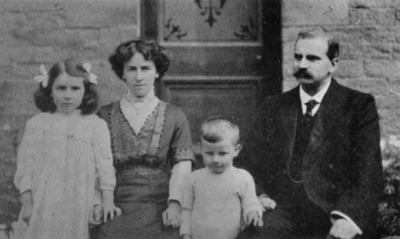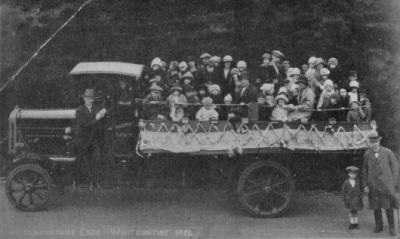6 World War One and after
1912 saw the calling to Lee Mount of the man described as a ‘stormy petrel,’ namely the Rev. John Brown from Lineholme, Todmorden. His coming coincided with the drawing up of a ‘Church covenant,’ the content of which is not now known. There was to be little time before the outbreak of World War I but we learn that missionary activity in the church was strong. Ladies were busy visiting the hospital and ‘local workhouse,’ and great effort was being made to erase the debt on the church.

In that fateful year of 1914 the Baptist Union met in Halifax and the church provided stewards for this great occasion. 1912 also saw the clearing of the debt and the resulting ‘good feeling’ that followed. But ‘war’ was on everyone’s lips. Immediately 13 men joined up and the activities of the church began to be affected by war-time conditions. There are references to the ‘Mayor’s War Fund,’ ‘blackouting,’ ‘sending comforts to the boys’ etc. The church, however, was not prepared to stand still and efforts were made to inspire the spiritual life. A Junior Christian Endeavour was formed at this time. Before the conflict ceased, three key workers were lost by death, Clement Hoyle, Secretary of the committee responsible for building the church, and Henry Townsend, a former church secretary and deacon. Mr Brown felt called strongly to minister to the troops and went to France as a chaplain on a number of occasions during his ministry at Lee Mount.
After the First World War something happened to the Churches. It has never been satisfactorily explained. Perhaps it was the inability to reconcile the Christian gospel with what happened at the Battle of the Somme and elsewhere. The fact is that the 1914/18 war is the great turning point after which church growth began to decline. So the ‘roaring twenties’ dawned, ‘flappers,’ ‘Charleston’ and all! Politically Ramsey Macdonald led the first Labour government, women were given the vote, the general strike took place and Wall Street crashed. Truly momentous days!
The ministry of the Rev. John Brown came to an end in February 1919. He had served the church for six and a half years. A man with a heavy moustache and a good big voice, he is remembered for encouraging young men of the church to fight for their country. Seventy seven young men joined up, which is a measure of the strength of the church at that time. Four failed to return. Mr Brown went to Zion, Morecambe, and was succeeded by the Rev. Horace Carr, B.D., who was introduced to the church in his naval uniform, looking very smart! This was his first pastorate. Also in that year, 1919, a young man from the church entered Rawdon College to prepare for the ministry. His name was Bernard Wilson and we were very pleased that he was able to share with us in the re-opening service of the new sanctuary in 1977. 1918 saw the passing of one of the last living links with the earliest days of the course, when John Henry Hooson died, a member of the Church for over 40 years. The following year William Bradley resigned after 38 years as Treasurer.
Prior to 1920 the Church did not own a manse. The minister rented local houses, but with the shortage of houses after World War I, the first manse was purchased. This was ‘Shroggs Villa’ and cost the princely sum of £425. This was the first of a number of subsequent manses.
Among the highlights of these years was the ‘Internal Mission’ spearheaded by the Yorkshire Association. Also the great Jubilee Celebrations of Easter 1922 which celebrated fifty years since the opening of the first church at Lee Mount. Out of this came the Memorial Organ in memory of the war dead, dedicated in 1924, and also a history of the church. Mr Carr concluded his ministry at Lee Mount at the end of 1923, going to Chorlton Baptist Church, Manchester. Appreciation was expressed for his ‘cultured, helpful ministry.’ lt is claimed that on one occasion Mr Carr said from the pulpit that ‘nobody these days believed that Balaam’s ass actually spoke!’ A lady in the congregation retorted, ‘Well, I do for one!’ Infant dedication was unknown at Lee Mount until 1923 when Mr Carr’s daughter, Kathleen, was dedicated.

Efforts continued to improve the premises. A new toilet block was built and then part of the premises was converted to electric lighting. That the world impinged on the life of the church is clear from a reference to a ‘collection in aid of children of engineers locked out’ (1922), ‘because of shortage of coal the morning service will be held in the lecture room’ (1926 Miners’ strike), and representatives be appointed to the ‘No More War Conference’ (1925).
In 1925 the Rev. Richard Tallontire came to the church. He was its sixth minister. He lives on still in the memory of our senior church members., remembered for his organising ability, his keen interest in young people, his intensity and sincerity in the pulpit and his love of cricket and rambles. One of the oldest men to settle at Lee Mount, he was largely self-taught and caused grief to many when he died, after much suffering, shortly after relinquishing the pastorate. His obituary in the ‘Halifax Guardian’ spoke of him as ‘the friend of all.’
During Mr Tallontire’s ministry a ‘Young Worshippers League’ was formed and the Yorkshire Association held its Autumn Assembly at the church. A ‘Mutual Improvement Society’ was formed in 1931 and special meetings were arranged in order to deepen the spiritual life of the church. The annal report of 1931, although grateful for the 20 new members added (membership 151), comments that ‘the great insecurity of the time has not driven men and women to find new comfort and hope within the Christian Church.’ (There were nearly three million unemployed in that year.) Nevertheless in May 1933, the twenty-fifth anniversary of the opening of the ‘new’ church was celebrated. These were meetings of ‘remarkable interest’ attended by the first minister of the church, Rev. F.W. Duncombe and Mr William Bradley (who embodied the spirit of Lee Mount) among others. This period saw the demise of a number of significant members of the church. Such a one was Mrs Naomi Townsend who was baptised in 1864 (died 1929) and ‘enjoyed nothing more than telling the early struggles of this course.’ A year later Mr A Wilson, treasurer and Deacon for 22 years, and Mr E Sutcliffe, deacon for 23 years, both retired from the diaconate.